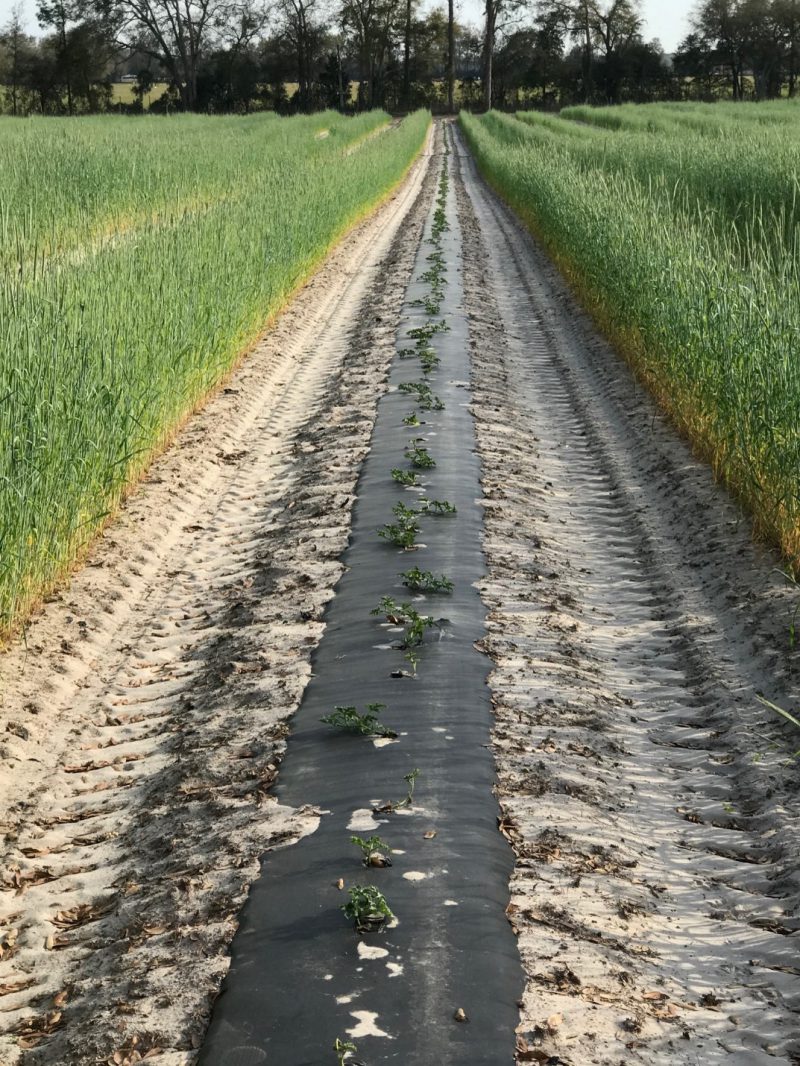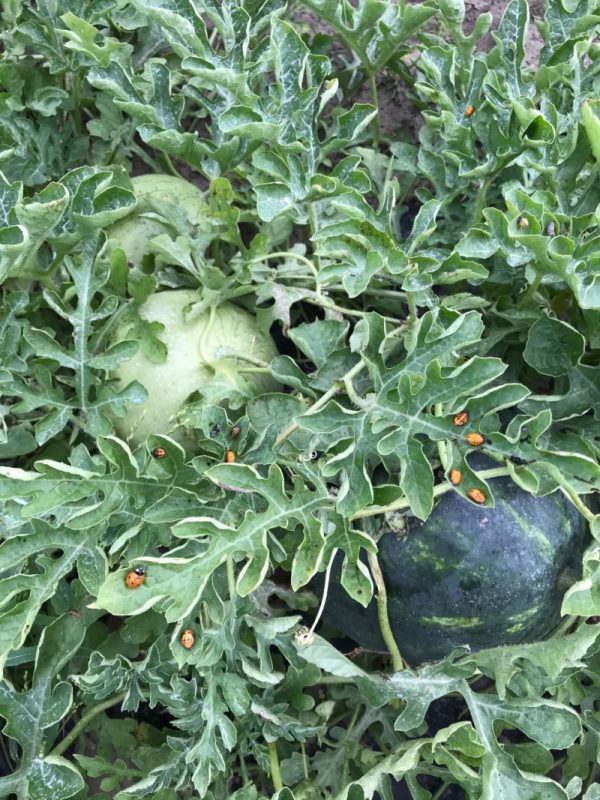UF/IFAS Extension Suwannee Valley Weekly Watermelon Crop Update. Bob Hochmuth, Mark Warren, Tyler Pittman, Tatiana Sanchez, Luke Harlow, Jay Capasso, Sylvia Wills, Dan Fenneman, Keith Wynn, Danielle Sprague, Kevin Athearn, and Charles Barrett
–
General crop and disease update
The crop has continued to rebound from the frost in early April. The favorable temperatures helped this recovery, and we see good fruit setting throughout the region. On one hand, the rainy days this past weekend brought needed soil moisture but on the other, they have set up the situation for diseases to get started. All reports last week were pretty similar; Fusarium wilt is very active across the region, with numerous reports of significant plant loss this past week. Dr. Nick Dufault will be working with us on collected samples to determine which races of Fusarium are common in the area. There are no effective control measures to be implemented against Fusarium at this time of season.
With the few days of rain, we expect to see more foliar diseases this week, so let your county agent know if you see new disease symptoms. Since fields have been pretty much disease free until now, it is a little difficult to know what to spray this week? Here are options to consider: Continue with Chlorothalonil (Bravo) or Manzate plus copper until we see symptoms and guide the spray choices as a result of our findings. The other option is to start a more aggressive preventative approach with Miravis Prime or Inspire Super. Inspire Super is the better choice, if gummy stem blight has been present in the field. One of our concerns going into this year is the general reduction of effectiveness of our standby materials for powdery mildew. These have included Torino, Quintec, and Procure, but none of these are “excellent” like they used to be. In some cases, Quintec and Procure had decent activity last year, but both also performed poorly last year in certain fields. Research suggests an even higher level of resistance to Torino. As a result, I think we may choose to get started soon with something like Miravis Prime or Inspire Super and come back with Manzate plus Quintec or Procure. Keep in mind, we are only one month from being in the early harvest season. (Bob Hochmuth, Mathews Paret)
–
Nutrient sufficiency ranges for Florida watermelons
Many producers and consultants use tissue sampling as an important management tool for in-season fertility assessments. Like sap testing, it is important to recognize that tissue tests are just a snap-shot views of the crop, at the time the sample was collected. Results can be affected by many factors (time of day, cloud cover, stage of maturity, time since last fertilizer application). Tissue analysis and sap tests are most valuable when taken consistently, routinely and then considered over time.
Sample collection is the most critical part of the process. Representative samples are essential. Avoid taking samples from areas that have symptoms not related to nutrition (disease, cold, insect, drought…) Some labs may suggest different sampling protocols (whole plant, petiole, full leaf), but UF/IFAS research, including the nutrient sufficiency/ deficiency ranges, are based on samples of the “most recently matured leaf” (MRML). Regardless of the lab that you choose, you should submit samples using the MRML (5-6th leaf from tip) as these will most accurately correlate to the published information for Florida crops and conditions.
- 15-20 leaves
- Full leaf samples collected/ submitted in paper bag
- Petioles for sap testing should be collected, immediately trimmed (petioles only), put in plastic bags and immediately tested, or stored in a cooler with a little ice or refrigerated, if testing will occur after a couple of hours. Samples must be brought to room temperature for testing.
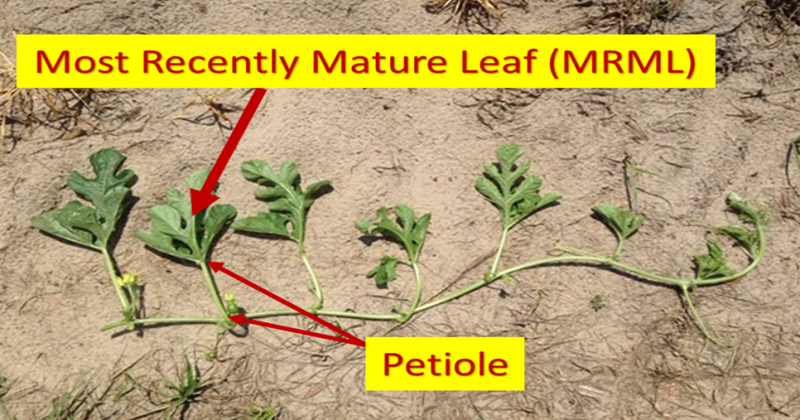
Depiction of the most recent mature watermelon leaf for sampling purposes. Credit: Bob Hochmuth, UF/IFAS
–
When nutrient related stress is suspected, it is best to submit a “good” versus “bad” set of samples so that the results can be compared.
Results from different labs can vary in how they are presented. Units of measure may differ, graphic elements may be included, and even corrective recommendations may be offered, but all accredited labs using common methods should provide reasonably similar numeric results.
It is important to recognize that the interpretation of the results (the pretty part of the report) may or may not take your local crops, soils, and conditions into account. While easy to look at, bar graphs may be misleading. Use the values from the tables below to interpret your results, so you will have a more regionally accurate indication of your crop’s status. Macronutrients are expressed in percentage (%) and micronutrients in parts per million (ppm).
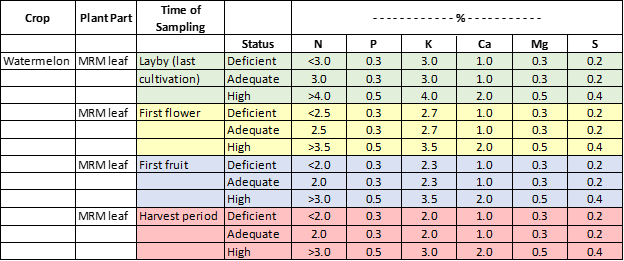
Adapted from, Plant Tissue Analysis and Interpretation for Vegetable Crops in Florida. HS964.
–
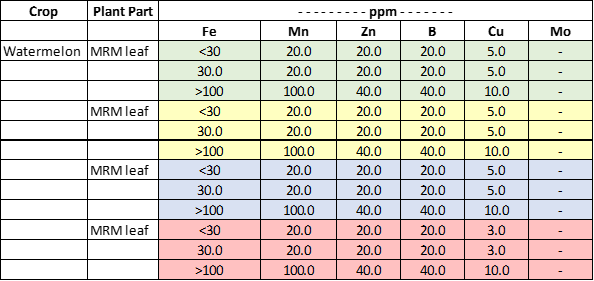
Adapted from, Plant Tissue Analysis and Interpretation for Vegetable Crops in Florida. HS964.
–
Reminder: If you would like more information or need assistance with tissue or sap testing, contact your local UF/ IFAS Extension agent. (Mark Warren)
–
Giving rye strips proper recognition
We have been using rye as a windbreak in watermelon fields for years in the Suwannee Valley. This spring they were put to the test, did their job, and now have been put to rest. Tyler Pittman and Bob Hochmuth were in a conversation recently about the hidden merits of rye in our watermelon production system. Here are the points in honor of the role rye plays in our system.
Rye, when established early, can serve as a windbreak, and protects the young crop from high winds in March and April.
–
Of the small grain options here, rye generally provides the greatest growth in the winter when temperatures are cool. Studies have shown that the effective distance of wind reduction on the lee side (protected side) of a windbreak is at least 10 times the height of the windbreak. So, the taller the windbreak, the greater the distance it provides protection. A 4 to 5-foot-tall windbreak should provide 40-50 feet of protection, assuming the rye strips are perpendicular to the wind direction. Along with just the wind alone, we see great damage when sand is blown too. These issues are all familiar, but rye has some other features as well. The aphids usually found feeding in rye is a grain aphid that poses no threat to watermelon. However, these grain aphids are a food source for many beneficials, but mainly lady beetles in the Suwannee Valley. We frequently see high populations of lady beetles on watermelon rows next to the rye windbreaks.
–
Cereal rye also produces several compounds in its plant tissues and releases root exudates that inhibit germination and growth of weed seeds. These allelopathic effects, together with cereal rye’s ability to smother other plants with cool weather growth, make it an ideal choice for a windbreak. Have you ever noticed there is little to no nutsedge in the rye windbreaks when the rye is actively growing? This allelopathic effect of rye is why few weeds are associated with rye strips, especially when the rye is started early. A healthy rye windbreak, after it is mowed down can also provide cover to the soil keeping the soil cooler and helps in shading out weeds in the row middles (Bob Hochmuth and Tyler Pittman).
–
Note: Planning is underway for a field day in early May related to controlled release fertilizer demonstrations- stay tuned
–
Thank You to the Suwannee Valley Rapid Diagnostic Watermelon Program and Its Industry Sponsors: UF/IFAS Extension agents have initiated a more formal way to support our watermelon growers with a rapid diagnostics system through Suwannee Valley Regional. This industry-funded program allows Extension Agents to submit and pay for watermelon grower plant disease and other diagnostic samples. This SV Rapid Diagnostic Watermelon Program will help us to get quicker diagnostic results and not have to charge the growers directly. Plant disease samples are typically $40 and leaf tissue analyses are typically $20. We want to thank the initial sponsors of this program: Syngenta Crop Protection, Harrell’s Fertilizer, Koppert Biological Systems, SEEDWAY LLC, BASF Vegetable Seeds, Bayer Crop Science, and Gowan Seed for sponsoring this effort. Other industry reps interested in sponsoring this effort can contact Bob Hochmuth at bobhoch@ufl.edu or 386-288-6301.
- 2024 Watermelon Season Wrap Up - June 21, 2024
- Weekly Watermelon Update – June 3 - June 7, 2024
- Weekly Watermelon Update #10 – May 20 - May 24, 2024

